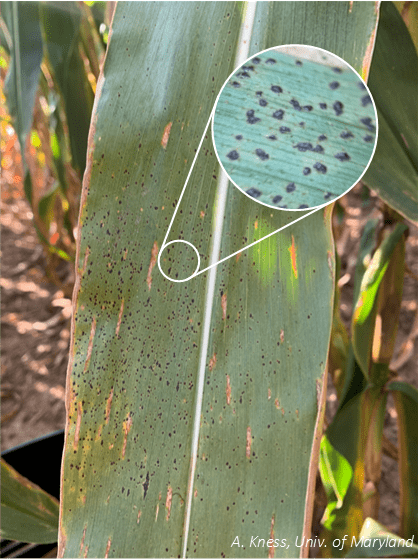Andrew Kness, Senior Agriculture Agent | akness@umd.edu
University of Maryland Extension, Harford County

Tar spot of corn has been confirmed in Maryland for the 2023 growing season. The first report came from a field in Cecil county on August 22, followed by several additional reports in Harford and Carroll county (Figure 1).
Tar spot is a relatively new fugal disease of corn in the United States and it was confirmed for the first time in Maryland in August of 2022. As daytime and nighttime temperatures begin to decline, now is a good time to look for symptoms in your corn fields. Tar spot is favored by cooler temperatures (60-70s), as well as prolonged periods (7+ hours) of leaf wetness from rainfall, dew, or humidity. Tar spot can cause infected plants to senesce prematurely, which can adversely affect yield, especially if infection occurs early in the reproductive stages. Yield losses are not as severe if infection occurs later in the reproductive stages.
Tar spot spores overwinter in old corn crop residue and are deposited onto corn leaves via splashing rain or wind (spores are only wind-blown for very short distances). Once a spore lands on corn tissue, it will germinate and infect the plant as long as the environmental conditions remain conducive. After an incubation period of about 14-21 days, black reproductive structures, called stroma, are visible on the leaf surface (Figure 2). These structures resemble black paint or tar, hence the name “tar spot.”

If you find tar spot in your field, you may want to take precautions to try to prevent its spread during harvest, as you could potentially inoculate new fields by bringing infected residue into the next harvested field. If you’re harvesting an infested field, it would be a good idea to try to remove as much corn fodder off of the equipment before moving to the next field.
Preparations for managing tar spot in 2024 should start in the winter with good seed selection. If possible, choose hybrids with good tar spot resistance (there is no complete resistance); seed companies are starting to rate hybrids for their tar spot resistance/tolerance.
If you find tar spot in your field, I would be interested in knowing about it. We have a grant from the Maryland Grain Producer’s Utilization Board and one objective of the study is to determine the distribution of tar spot in Maryland. Call (410-638-3255) or email me (akness@umd.edu); or submit a report at corn.ipmpipe.org.
